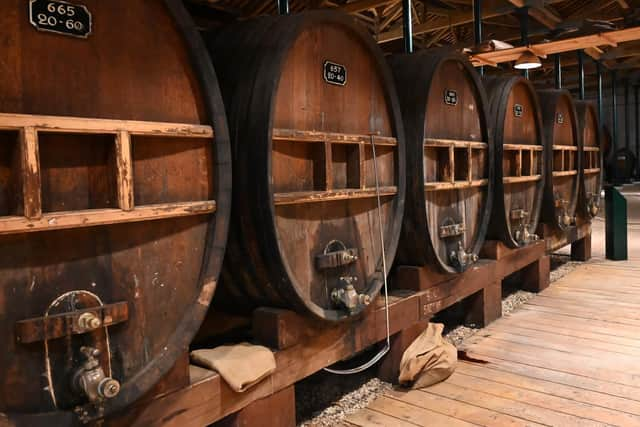Why vermouth might be the tonic we need right now - Christine Austin


Not that gin goes out of fashion in winter months, but there is something about longer evenings, the prospect of sunshine and the chance to spend more time in the garden that makes gin a natural drink to turn to. But apart from tonic, what else can you put in your gin?
Apparently it was back in 1912 that Martini di Arma di Taggia, the barman at the Knickerbocker Hotel in New York added Noilly Prat vermouth to gin and then garnished it with a twist of lemon. He served the drink to John D Rockefeller, who decided it was so good that it should be named after its creator, and that was how the martini was invented.
Advertisement
Hide AdAdvertisement
Hide AdWhether the date, the drinker and the ingredients are absolutely correct is difficult to verify, but the martini was invented in New York, and it has always needed some vermouth to give it the right flavour.


Almost 100 years before the martini was invented, Joseph Noilly came up with a process to add aromatic herbs and flavours to wine. His son Louis and son-in-law Claude Prat joined forces and developed the idea. They established Noilly Prat, and moved to an old absinthe factory in Marseillan where production still takes place. From the roadside, the building is smart and modern, but once you get through the shop and presentation areas, it leads straight into a massive maturation cellar, stock rooms and a vast open courtyard full of barrels.
In an echo of this building’s past there is a tight, corkscrew-like spiral staircase which climbs the wall of the old absinthe distillery. The staircase was designed by Gustave Eiffel, and it stands there, beautiful and neglected, a remnant of another age.
The process of making Noilly Prat has hardly changed since it was invented.
Advertisement
Hide AdAdvertisement
Hide AdTwo key grape varieties are used, both harvested locally and selected particularly for their taste. Piquepoul translates as “lip-stinger” and it is the biting freshness of the grape that is useful in the blend. Clairette du Languedoc is also used, adding balance and length. Neutral alcohol is then added to the wine, which boosts the alcohol level up to around 16 per cent and stops fermentation, leaving a “mistelle” with natural grape sugar remaining. This is then aged in vast casks for around a year.
Another part of the blend is aged outside in smaller casks, exposed to the wind, rain and sunshine. This mimics the process that the wine used to endure when it was exported by ship, but now, in the quiet of the courtyard, around 2,000 old barrels, some of them old sherry butts and some previously used as Scotch whisky barrels, rest for a year. They are sprayed with water twice a day to prevent them from cracking but essentially the wine inside matures, evaporates and develops a complex range of flavours.
It is at this point that the wines are blended and “aromatised”, using a blend of herbs, spices and flowers, depending on the eventual product being made.
When I walked into the compounding area where the flavouring ingredients are kept, it was amazing to smell the heady mix of rose petals, camomile, cloves, lime zest and nutmeg which are part of the flavouring process. Noilly Prat is one of the few vermouth producers to use the physical herbs and spices for compounding rather than rely on a mix of essences.
Advertisement
Hide AdAdvertisement
Hide Ad“Is this the whole selection of flavourings used?” I asked Stéphane Senay, who has been cellar master at Noilly Prat for 17 years. He smiled and said: “Not quite.” “There are other small additions of particular herbs which make Noilly Prat keep its unique flavours,” he said. “So how many people actually know the complete recipe?” I asked. “Possibly only two people know everything that goes into each type of Noilly Prat,” Stéphane admitted.
The flavouring ingredients are weighed out and around three sacks of herbs and spices are added to each 2,000-litre large vat. For three weeks, each vat is stirred every day using a long handled scythe-like stirrer that tracks the shape of the inside of the vat and keeps the flavourings in suspension.
Eventually the flavour extraction is complete and the vermouth is taken off this bed of flavourings, filtered and bottled, but not before Stéphane has checked it to make sure it is correct. His taste buds have been tuned to perfection to make sure that each bottling is exactly right.
There are four main styles of Noilly Prat. Dry Original has a soft, herbal note with lemon zest and a creamy finish. It is the perfect vermouth to create a martini.
Advertisement
Hide AdAdvertisement
Hide AdExtra Dry has more camomile and lime, while Ambré is definitely sweeter with a sherry-like nose and floral tones. There is also a red Noilly Prat, which is packed with spice, chocolate and cinnamon flavours.
Towards the end of my tour, Stéphane allowed me to create my own particular blend of vermouth, using the main base wines with various flavouring additions. As I proceeded to add drops of lemon zest, a touch more Piquepoul and a tiny drop of mistelle, I asked Stéphane for his opinion. “Not bad,” he said, although the wrinkling of his nose told me he didn’t like it. He reached for another tiny bottle and added a couple of drops. That put the whole glass in balance, with each herb, spice and sweetness in harmony. All I needed was a tot of gin to create my own martini.
Maison Noilly Prat in Marseillan is generally open every day, for purchases, guided tours and blending workshops.
